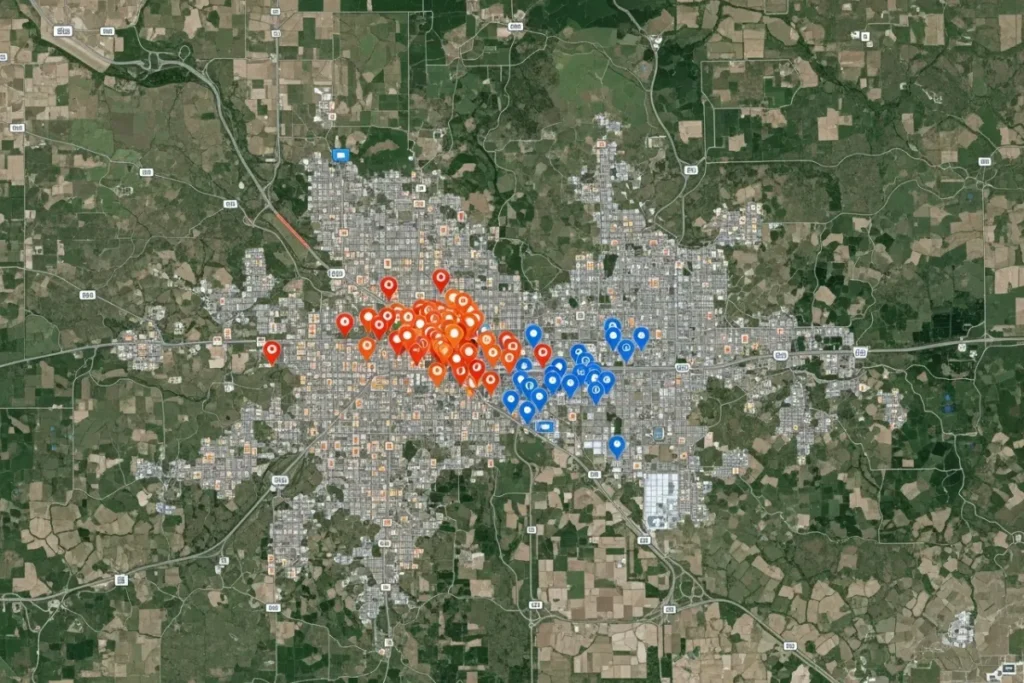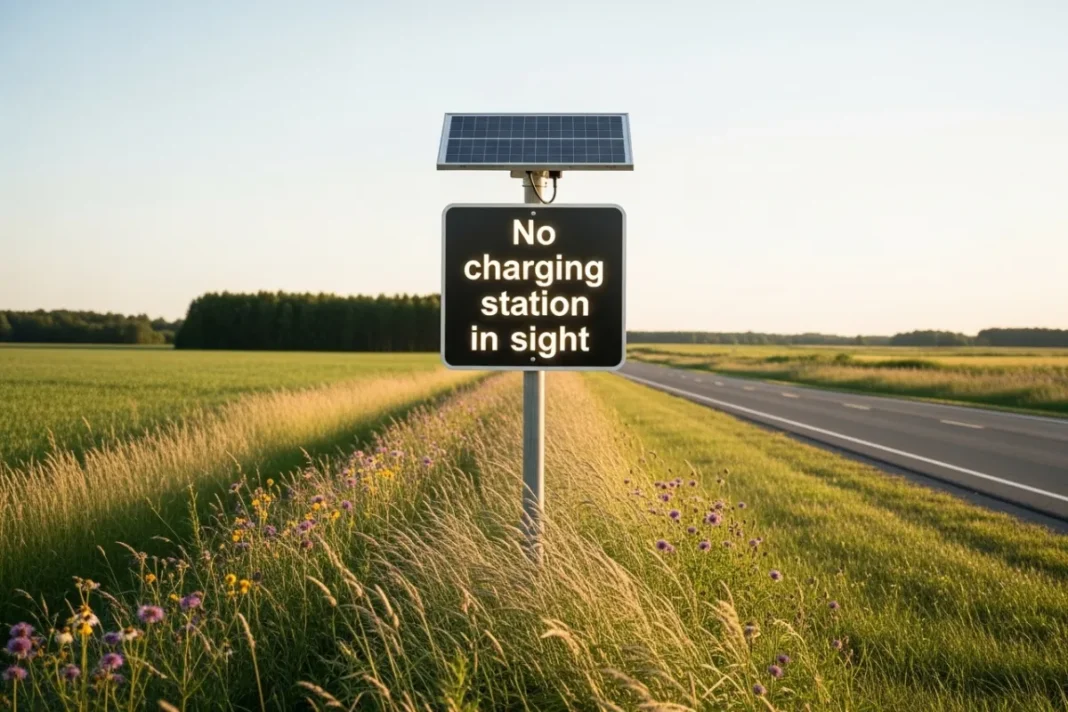This blog post delves into the challenges of EV charging in rural areas, emphasizing the disparity in charging infrastructure compared to urban centers. It explores the socio-economic impacts of limited access to EV charging in rural areas stations and the urgent need for targeted government initiatives and community engagement to bridge this gap. By highlighting voices from rural communities and proposing potential solutions, the article advocates for equitable access to sustainable transportation options. Join the conversation on improving EV infrastructure to create a greener future for all, regardless of geographical location.
Table of Contents
Introduction To EV Charging in Rural Areas
As the global community pivots towards sustainable energy solutions, the increasing popularity of electric vehicles (EVs) has garnered significant attention. EVs present a compelling avenue for reducing greenhouse gas emissions and dependence on fossil fuels. However, the widespread adoption of electric cars in the countryside is met with considerable challenges, particularly concerning the availability of public EV charging in rural areas infrastructure. This disparity in access to EV charging in EV Charging in Rural Areas stands as a formidable barrier that must be addressed if we are to realize the potential of electric vehicles.
The landscape of charging station disparity is exacerbated in rural regions where infrastructure is often underdeveloped. Unlike urban settings that benefit from relatively abundant resources and governmental support, EV Charging in Rural Areas frequently experience a lack of charging stations, leading to ev access inequality. The limited availability of charging facilities not only impedes potential EV owners from making the switch but also hampers the overall appeal of moving towards an electric future in such locations. Additionally, the growing number of electric cars in the countryside necessitates adequate EV charging rural solutions to accommodate their needs effectively.
The plight of rural infrastructure and EV integration is intertwined with economic and policy decision-making as well. Government oversight has largely favored metropolitan areas, leaving rural communities vulnerable and disengaged from the progress made in the realm of clean energy. Therefore, this blog post posits that unless there are substantial investments and initiatives directed toward enhancing EV charging in rural areas infrastructure in remote regions, the promise of electric vehicles will remain unfulfilled for many. Understanding the implications of this infrastructure marginalization is vital for promoting equitable access to electric mobility options, ensuring that all communities are empowered to contribute to and benefit from the shift towards cleaner transportation.
The Rise of Electric Vehicles
The transition towards electric vehicles (EVs) has gained remarkable momentum globally, driven by a confluence of environmental awareness, technological advancements, and governmental support. As individuals and communities increasingly recognize the detrimental effects of fossil fuel consumption, the push for cleaner alternatives has never been more pronounced. This shift is underscored by a growing trend towards electric cars, which are becoming pivotal in efforts to reduce greenhouse gas emissions and combat climate change.
In recent years, governmental bodies across many nations have implemented various incentives geared towards the adoption of electric vehicles. These incentives often include tax rebates, grants for EV purchases, and investments in charging infrastructure, particularly in urban areas where population density makes the deployment of charging stations more viable. However, this urban-centric focus has inadvertently highlighted a significant disparity in EV access, particularly as it pertains to EV Charging in Rural Areas. While urban regions experience a surge in EV sales, rural markets remain stagnant, reflecting the challenges posed by inadequate infrastructure.
Statistics illustrate these contrasting trends vividly. For instance, according to recent data, urban areas are witnessing an annual increase of over 25% in electric vehicle sales, while rural regions struggle with a mere 5% growth rate. This stark difference raises questions about EV charging in rural areas station disparity and the implications of limited EV charging options in the countryside. As electric cars become more mainstream, addressing rural infrastructure and ev charging disparities becomes critical to ensure all communities have equitable access to electric mobility.
The implications of access inequality are vast. As EVs become integral to future transportation solutions, fostering infrastructure in EV Charging in Rural Areas must be a priority. Otherwise, the potential of electric vehicles to contribute to sustainability efforts may be undermined in these less populated regions, leaving residents without the benefits and conveniences enjoyed in urban settings. Simply put, advancing EV technology must be accompanied by a steadfast commitment to creating a robust charging network that stands to benefit every individual, regardless of their geographical location.

Understanding Infrastructure Challenges
The advancement of electric vehicles (EVs) across various regions has highlighted the critical role of infrastructure, particularly in EV Charging in Rural Areas where geographical isolation poses significant challenges. Unlike urban environments, where the concentration of consumers can make the establishment of charging stations more feasible, rural regions often suffer from lower population density. This demographic reality complicates the deployment of a comprehensive network of EV charging stations, creating a disparity in access to EV infrastructure.
Moreover, rural communities frequently face economic constraints that hinder the development of necessary infrastructure. Limited financial resources can lead to prioritization of other essential services over the establishment of charging networks. Consequently, the lack of investment in EV charging rural infrastructure not only affects immediate accessibility but also deters potential electric car users from considering EVs as viable options. These economic challenges amplify the charging station disparity, making it difficult for rural residents to engage with the growing trend of electric vehicles.
Furthermore, the physical distance between homes and potential charging locations in the countryside can discourage current and prospective EV users. The inconvenience associated with the limited availability of charging stations further perpetuates the perception that electric vehicles are not suitable for rural living. Such perceptions can limit consumer interest and dissuade individuals from making the transition to electric cars, thereby exacerbating ev access inequality. This situation creates a cycle where the lack of infrastructure leads to reduced EV adoption, which in turn impacts future investments in rural charging solutions.
Addressing these infrastructure challenges is vital for creating a balanced EV ecosystem that includes EV Charging in Rural Areas. By acknowledging the importance of developing infrastructure tailored to the unique needs of rural communities, it becomes evident that overcoming these hurdles is essential for achieving equitable EV access across all regions.
Government Initiatives and Failures
Government initiatives aimed at promoting electric vehicle (EV) adoption are becoming increasingly important in addressing the needs of a changing transportation landscape. However, a significant shortfall remains when it comes to the effective deployment of EV charging infrastructure in EV Charging in Rural Areas. While urban centers often enjoy numerous charging stations, the stark disparity between urban and rural EV access is a growing concern. A disparity that ultimately risks sidelining rural populations in the ongoing transition to electric cars.
Many government policies are designed with a broad brush, focusing primarily on urban development without taking into account the unique challenges faced by rural communities. Initiatives such as tax credits for EV purchases have proven beneficial in urban areas but do little to resolve the lack of charging stations in the countryside. In some cases, funding allocations for charging infrastructure have been insufficient or mismanaged, leaving rural communities without the necessary support for EV adoption. For instance, while a large budget may be allocated to public charging stations in cities, the same resources often do not extend to rural infrastructure projects.
One notable example of this oversight is the failure of some government-funded programs aimed at expanding EV charging networks, which overlooked the specific needs of residents living in remote areas. The result has been a persistent “charging station disparity,” where those living in cities have easier access to the necessary infrastructure, while those in more isolated regions remain underserved. This lack of focus on rural infrastructure not only inhibits the appeal of electric cars in these areas but also exacerbates EV access inequality across the board.
As governments push for increased EV adoption rates, it is imperative that they also acknowledge and address the systemic failures in facilitating proper infrastructure development. A targeted approach that considers the specific needs of rural populations is essential for the successful integration of electric vehicles into the countryside. If these issues are not rectified, policies may simply perpetuate existing disparities rather than bridging the gap for rural electric vehicle users.

Comparison with Urban Infrastructure
The expansive growth of electric vehicle (EV) adoption in urban environments has been significantly aided by a robust charging infrastructure supported by both governmental policies and private investments. Urban areas, characterized by higher population densities, have witnessed a proliferation of charging stations, leading to an environment where electric cars can be efficiently integrated into daily commutes. Data from various government reports indicate that urban centers contain approximately 70% of the nation’s charging stations, creating a stark contrast with EV Charging in Rural Areas.
In urban settings, initiatives such as tax incentives, grants, and business partnerships have fostered the establishment of extensive EV infrastructure. For example, numerous cities have seen charging stations installed in public parking lots, retail centers, and along highways, contributing to user convenience. Furthermore, as urban dwellers often have greater access to resources and information regarding EV charging locations, the adoption rate of electric vehicles in cities has soared.
Conversely, EV Charging in Rural Areas experience a notable deficiency in EV charging infrastructure, an aspect referred to as “charging station disparity.” This lack of investment results in severe limitations for electric car users in the countryside, where the availability of charging points is minimal. Statistics reveal that rural regions may have only one charging station for every fifty square miles, severely hindering the practicality of owning electric cars in these areas. Moreover, the geographical expanse of rural zones often exacerbates the challenges associated with accessing charging facilities. As electric cars gain traction in broader automotive markets, the disparity in EV access inequality between urban and rural settings remains a pressing concern.
This gap not only affects EV adoption rates but also reflects broader issues of rural infrastructure development and investment. To bridge this divide, targeted funding and policy initiatives aimed at enhancing EV charging capabilities in EV Charging in Rural Areas are essential to ensure equitable access to sustainable transportation solutions.
The Socio-Economic Impact of Limited Infrastructure
The disparity in electric vehicle (EV) charging infrastructure between urban and EV Charging in Rural Areas greatly affects the socio-economic landscape of many communities. Rural residents often find themselves at a disadvantage when it comes to adopting electric cars in the countryside due to the lack of accessible charging stations. This limited infrastructure not only hinders individual mobility but also impacts the local economy in several significant ways.
Firstly, the inadequate availability of EV charging options can deter potential electric car buyers. Many consumers are hesitant to invest in electric vehicles when they perceive a lack of reliable and convenient charging opportunities. This reluctance can stall the broader adoption of electric vehicles, perpetuating a cycle where EV Charging in Rural Areas lag behind their urban counterparts in transitioning to cleaner transportation methods. Consequently, the anticipated environmental and economic benefits associated with increased EV usage, such as job creation in renewable energy sectors, remain untapped.
Moreover, charging station disparity also affects local businesses. They may lose out on potential customers who prioritize convenience and charging accessibility when traveling in electric vehicles. Visitors and tourists, attracted to areas with sustainable transportation options, may choose to bypass rural locales due to concerns about charging access. This potential loss of revenue can become a significant hurdle for local enterprises striving to adapt to the evolving automotive landscape.
The inequities in EV access exacerbate existing mobility challenges faced by rural residents. Limited transportation options can isolate individuals, restricting access to vital services, employment opportunities, and social connections. The connection between economic development and adequate transportation options cannot be overstated, as effective rural infrastructure is critical for fostering community growth and resilience. Addressing these disparities in electric vehicle charging infrastructure is essential for ensuring that rural communities do not fall further behind in a rapidly evolving economy driven by sustainable transportation solutions.

Voices from the Rural Community
The rise of electric vehicles (EVs) is particularly prominent within urban environments, yet rural communities often find themselves at the periphery of this revolution. Interviews with residents from various EV Charging in Rural Areas illustrate the challenges and frustrations they face regarding EV charging access. One resident from a small town in the Midwest shared, “I decided to buy an electric car thinking it would be a more sustainable choice, but I quickly realized the nearest charging station is over thirty miles away. This significantly undermines the convenience I assumed I would have.” Such sentiments are common as rural infrastructure struggles to keep pace with the growing demand for EV charging options.
Another resident echoed this sentiment, stating, “The disparity is evident; while cities have charging stations every few blocks, we have to rely on gas stations.” The lack of EV infrastructure can deter potential electric car owners in the countryside, perpetuating the notion of ev access inequality. Many residents highlight that despite the government’s pledge to promote green technologies, little has been done to address the specific needs of rural regions.
In addition to logistical challenges, residents often express frustration with the perceived disconnect between their realities and government policies. A farmer remarked, “We are being encouraged to go electric by policymakers who seem to forget that many of us live miles away from any reliable charging station.” This lack of specialization in rural needs adds to the overall concern about charging station disparity; without tailored solutions, EV adoption remains limited in these communities.
As voices from the rural community highlight, the intersection of electric cars and countryside living requires urgent attention. Addressing these issues not only promotes the adoption of EVs but fundamentally nurtures the sustainability goals that underpin the broader transition to cleaner energy.
Potential Solutions and Initiatives
Improving EV charging infrastructure in EV Charging in Rural Areas is essential to address the disparity in access to electric vehicles, particularly as the world shifts towards more sustainable transportation options. Various strategies can be implemented to enhance access to EV charging in the countryside, ensuring that residents are not left behind in the transition to electric cars.
Public-private partnerships present a viable solution to facilitate the development of charging stations in these regions. By collaborating with private companies, local governments can leverage financial resources and expertise to expand infrastructure. Such partnerships may also create economic opportunities, incentivizing businesses to invest in charging points, thereby improving local infrastructure and providing residents with the necessary support to adopt electric vehicles.
Grant programs specifically designed for the installation of charging stations can play a crucial role in mitigating the issue of EV access inequality. State and federal funding can be directed towards rural communities to develop infrastructure that supports electric cars and addresses charging station disparity. By offering financial incentives to private entities and local governments, these grants can help establish a network of charging stations that encourages EV adoption.
Mobile charging solutions are another innovative approach that can cater to rural regions with limited infrastructure. Mobile charging units can be deployed during peak usage times or special events, ultimately providing temporary access to charging facilities. These units can adapt to local needs and can be powered by renewable energy sources, further promoting sustainability.
Lastly, empowering communities to drive their own initiatives can lead to effective solutions for EV Charging in Rural Areas. By organizing local efforts to install charging stations and educate residents about electric cars, communities can cultivate a culture of sustainability and promote the benefits of EV usage. Such grassroots movements encourage participation and foster a sense of ownership, ultimately leading to a robust rural infrastructure for electric vehicles.
| Strategy | Description |
|---|---|
| Public–Private Partnerships | Collaborate with private companies and local governments to share funding, expertise, and resources for installing charging stations. Creates economic incentives for businesses and expands charging infrastructure more quickly in underserved rural regions. |
| Targeted Grant Programs | Use state or federal grants to subsidize the cost of installing charging stations in rural areas. Financial incentives for municipalities and private developers help overcome upfront investment barriers and reduce access inequality. |
| Mobile Charging Solutions | Deploy portable, renewable‑powered charging units to meet temporary or peak demand (e.g., during community events). Offers flexible, on‑demand access where fixed infrastructure is not yet in place. |
| Community‑Driven Initiatives | Empower local residents to lead installation and EV‑education efforts. Grassroots planning and fundraising foster community ownership, raise awareness of electric vehicles, and build sustainable, locally managed charging networks. |
Conclusion: A Call to Action
The discussion surrounding EV Charging in Rural Areas has highlighted a critical concern: charging station disparity and its implications for ev access inequality. Currently, residents of rural communities face significant challenges in acquiring the necessary infrastructure to support electric cars in the countryside. The disparity in charging station availability not only restricts access to EVs but also hinders the adoption of sustainable mobility solutions in these regions.
As electric cars gain traction and become more mainstream, it is crucial that we prioritize the development of rural infrastructure for EV charging. This involves a collaborative effort among various stakeholders, including government entities, local businesses, and community organizations. Governments can take the lead by allocating resources, planning, and implementing policies that ensure equitable distribution of charging stations across urban and rural landscapes. Businesses can play a significant role by investing in infrastructure projects that serve these underserved areas, thus enhancing the accessibility of electric vehicles.
In addition, community engagement is essential to amplify the voices of rural residents on matters affecting their mobility. By raising awareness around the benefits of electric vehicles, communities can advocate for the necessary changes to overcome ev charging rural challenges. Furthermore, partnerships between local governments and private sector entities can enable comprehensive solutions that address the infrastructure gaps and foster a more inclusive environment for electric vehicle adoption.
Ultimately, sustainable mobility should not be confined to urban centers; it must be an accessible option for all communities regardless of their location. Addressing the EV charging infrastructure gap in EV Charging in Rural Areas is imperative for achieving this goal. Each stakeholder’s commitment towards overcoming charging station disparity will pave the way for a greener, more equitable future, where electric cars contribute positively to the fabric of all communities.






[…] A Revolution Without Infrastructure: Why Infrastructure Marginalizes EV Charging in Rural Areas […]
[…] A Revolution Without Infrastructure: Why Infrastructure Marginalizes EV Charging in Rural Areas […]
[…] A Revolution Without Infrastructure: Why Infrastructure Marginalizes EV Charging in Rural Areas […]